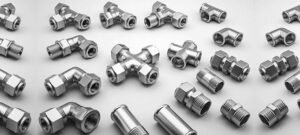What Are Instrumentation Fittings?
Instrumentation fittings are specialized components used to connect, seal, and support instruments in piping systems. They facilitate the safe and efficient transmission of fluids, gases, and signals between instruments, ensuring that measurement and control devices operate effectively. Instrumentation fitting Commonly found in industries such as oil and gas, chemical processing, pharmaceuticals, and food production, these fittings are essential for maintaining system integrity and performance.

Types of Instrumentation Fittings
- Compression Fittings:
- These fittings create a tight seal by compressing a ring (ferrule) against the tubing when tightened. They are widely used for connecting tubes to instruments and provide excellent sealing capabilities.
- Weld Fittings:
- Weld fittings are joined to piping systems through welding. This method ensures a permanent connection, ideal for high-pressure applications where leaks cannot be tolerated.
- Flanged Fittings:
- Flanged fittings consist of two flat surfaces with bolt holes for securing them together. They are commonly used in larger piping systems, allowing for easy maintenance and disassembly.
- Threaded Fittings:
- These fittings use male and female threads to create a secure connection. They are versatile and can be used in various applications, although they may not be suitable for high-pressure or high-temperature environments.
- Union Fittings:
- Union fittings allow for easy disconnection of piping sections without needing to cut the pipe. They are useful in applications where maintenance or replacement of components is required.
Key Functions of Instrumentation Fittings
- Sealing: Proper sealing is crucial to prevent leaks, which can compromise measurement accuracy and safety. Instrumentation fittings provide reliable sealing solutions tailored to specific applications.
- Support: These fittings provide mechanical support to the piping system, ensuring stability and reducing stress on connected components.
- Connection: Instrumentation fittings connect various instruments, valves, and pipes, allowing for efficient fluid and gas flow throughout the system.
- Flexibility: The variety of fitting types allows for flexibility in system design, enabling engineers to create customized solutions that meet specific operational requirements.
Importance of Choosing the Right Instrumentation Fittings
Selecting the appropriate instrumentation fittings is critical for several reasons:
- Accuracy: The right fittings ensure that measurements taken by instruments are precise. Any leaks or improper connections can lead to inaccurate readings, affecting overall system performance.
- Safety: In industries dealing with high-pressure or hazardous materials, proper fittings are vital for maintaining safety standards. Choosing fittings that can withstand the operating conditions helps prevent accidents and equipment failures.
- Longevity: High-quality fittings can enhance the longevity of an entire system. Investing in durable materials and designs reduces the likelihood of premature failures and maintenance costs.
- Compliance: Many industries are subject to strict regulatory standards. Selecting instrumentation fittings that meet these standards is essential for compliance and avoiding potential penalties.
Conclusion
Instrumentation fittings are often the unsung heroes of industrial measurement and control systems. Their role in ensuring accurate, reliable, and safe operations cannot be overstated. By understanding the different types and functions of these fittings, businesses can make informed decisions that enhance their systems’ performance and longevity.
When selecting instrumentation fittings, it’s essential to consider factors such as application requirements, material compatibility, and industry standards. By doing so, organizations can ensure they maintain the highest levels of precision and safety in their operations.
Whether you’re in oil and gas, chemical processing, or any other industry relying on instrumentation, investing in high-quality fittings is a step toward achieving operational excellence.